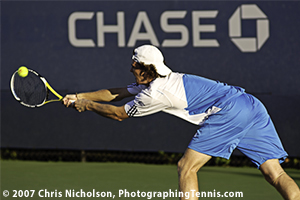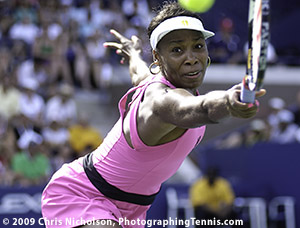

KEEP THE ENERGY IN THE PHOTO
When composing a tennis photo, remember to compose the action so it engages the viewer.
In any sports action photo, a general best practice is to keep the energy from moving out of the photo.
What do I mean by this? Ensure that the energy — whether it be the motion of the player, the direction of the action, etc. — is moving into the composition, rather than out of it.
Most people who have studied photography have come across the concept of composing a photograph so that living subjects are looking toward the center portions of the frame, rather than looking out toward the edges. This strategy applies to sports action, as well. If the action is moving away from the viewer, then it saps the energy of the photograph (not to mention that the player's eyes will be looking away from the composition). But if the action is moving toward the viewer, it makes the composition engaging and dramatic.

When the player and action are moving away from you, the action and energy appear to move out of the photo.
In tennis photography, because you’re almost always shooting from the side of the court, this means that you usually can’t shoot both backhands and forehands of the same player. Why not? Because if the player is moving toward you on the backhand, then he or she would be moving away from you on the forehand. (And vice versa.)

In most circumstances, a tennis photo is more dynamic when the action is moving toward the center of the composition or toward the camera.
The easiest strategy for applying this rule in tennis photography is to follow this mantra: Keep the ball between you and the player. That way the player’s focus and energy will always be aimed in the general direction of your lens. And then you will have captured the energy of the action.
